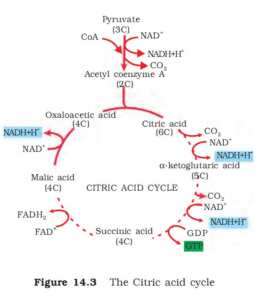Respiration in Plants MCQ/Objective questions Chapter 14 Biology
Breakdown of food materials to release energy occur in
- a. Green leaves
- b. Non-green leaves
- c. All cells
- d. Stem
Breakdown of food materials to release energy is termed as:
- a. Acellular respiration
- b. Cellular respiration
- c. External respiration
- d. None
Cellular respiration occurs in which part of cell
- a. Chloroplast
- b. Mitochondrial
- c. Cytoplasm
- d. Both b and c are involved
In respiration breakdown of which bonds of complex compound release energy
- a. C-C bond
- b. C-H
- c. Amide
- d. Phosphodiester bond
The end product in respiration is
- a. ATP
- b. CO2
- c. H2O
- d. All three
Why do we say ATP is ‘energy currency of the cell’?
- a. ATP has high energy phosphate bonds
- b. Cells convert them into ADP whenever they need energy
- c. The number of ATP is limited in the cell.
- d. None
The correct equation of cellular respiration is:
- a. 6CO2 + 6H2O + Energy → C6H12O6
- b. 6CO2 + 6H2O → C6H12O6 + Energy
- c. C6H12O6 + 6O2 → 6CO2 + 6H2O + Energy
- d. C6H12O6 + 6O2 → 6CO2 + Energy
All cells in whether in presence of oxygen or absence of oxygen undergo breakdown of glucose to pyruvate. The process is termed
- a. Glycolysis
- b. Gluconeogenesis
- c. Pyrolysis
- d. None.
In the EMP pathway end product is
- a. Water + ATP
- b. 1H2O+ 2 Pyuruvic acid + 2 NADH+H+
- c. 1H2O+ 2 Pyuruvic acid + ATP
- d. None
How many ATPs produced during glycolysis of one molecule of glucose?
- a. 4
- b. 5
- c. 6
- d. 7
Kreb’s cycle occurs in
- a. Cytoplasm
- b. Chloroplast
- c. Mitochondrial matrix
- d. None

Complete breakdown of one glucose molecule yiels how many ATPs
- a. 30 – 32
- b. 34 – 36
- c. 36 – 38
- d. None
Electron transport system in mitochondria is located at:
- a. Outer mitochondrial membrane
- b. Inner mitochondrial menbrane
- c. Mitochondrial matrix
- d. Spaces between inner and outer mitochondrial membrane.
- The Living world MCQ
- Biological Classification MCQ
- Plant Kingdom MCQ
- Animal Kingdom MCQ Biology
- Morphology of Flowering Plants MCQ
- Anatomy of Flowering Plants MCQ
- Structural Organisation in Animals MCQ
- Cell The Unit of Life MCQ
- Transport in Plants MCQ
- Mineral Nutrition MCQ
- Photosynthesis in Higher Plants MCQ
Respiration in Plants MCQ/Objective questions Chapter 14 Biology
Ref: Ref: Chapter 14.